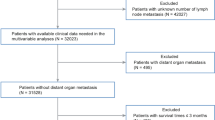Abstract
Background
In this study, we tested the hypothesis that the ratio between metastatic and excised lymph nodes (“N-ratio”) might have an independent prognostic value in patients with TNM stage-III cutaneous melanoma.
Methods
The clinical records of 213 melanoma patients who had undergone radical lymph node dissection (RLND) and were found to harbor pathology-proven metastatic disease were used for analysis. The following clinico-pathological variables were considered for the prognostic study: patient’s age and sex, primary tumor site, tumor thickness, Clark’s level, ulceration, absolute number of positive lymph nodes, total number of excised lymph nodes, TNM stage (IIIA, IIIB, IIIC), and N-ratio (N-ratio A, ≤10%; N-ratio B, 10–25%; N-ratio C, >25%).
Results
Patients were categorized into three N-ratio classes according to the percentage of metastatic lymph nodes (N-ratio A, n = 94; N-ratio B, n = 95; N-ratio C, n = 24). The mean follow-up was 40 months. At univariate survival analysis, tumor thickness (P < 0.0001), ulceration (P = 0.046), Clark’s level (P = 0.0002), number of positive lymph nodes (P < 0.0001), TNM stage (P < 0.0001), and N-ratio (P < 0.0001) were significantly associated with overall survival (OS). Interestingly, the Cox proportional hazard model showed that, along with tumor thickness (HR 1.069, P = 0.008) and TNM stage (HR 1.696, P = 0.015), N-ratio (HR 1.578, P = 0.012) also independently predicted OS.
Conclusions
N-ratio is a novel easy-to-obtain independent prognostic factor for melanoma patients with lymph node metastases and might provide clinicians with additional information suitable for patient stratification while choosing adjuvant treatment. Validation of these results in larger prospective series is warranted to implement N-ratio in the routine clinical setting.



Similar content being viewed by others
References
Balch CM, Buzaid AC, Soong SJ, et al. Final version of the American Joint Committee on Cancer Staging System for Cutaneous Melanoma. J Clin Oncol 2001; 16:3635–48
Balch CM, Soong SJ, Gershenwald JE, et al. Prognostic factors Analysis of 17,600 melanoma patients: validation of the American Joint Committee on Cancer Melanoma Staging System. J Clin Oncol 2001; 16:3622–34
Balch CM, Soong SJ, Atkins MB, et al. An evidence staging system for cutaneous melanoma. CA Cancer J Clin 2004; 54:131–49
Thompson JF, Scolyer RA, Kefford RF. Cutaneous melanoma. Lancet 2005; 365:687–701
Tsao H, Atkins MB, Sober AJ. Management of cutaneous melanoma. N Engl J Med 2004; 351:998–1012
Verna S, Quirt I, McrCeady D, Bak K, Charette M, Iscoe N. Systematic review of systematic adjuvant therapy for patients at high risk of recurrent melanoma. Cancer 2006; 106:1431–2
Kirkwood JM, Manola J, Ibrahim J, Sondak V, Ernstoff MS, Rao U. A pooled analysis of eastern cooperative oncology group and intergroup trials of adjuvant high-dose interferon for melanoma. Clin Cancer Res 2004; 10:1670–7
Lens MB, Dawes M. Interferon alfa therapy for malignant melanoma: a systemic review of randomized controlled trials. J Clin Oncol 2002; 20:1818–25
Wheatley K, Natalie I, Hancock B, Gore M, Eggermont Alexander, Suciu S. Does adjuvant interferon-α for high-risk melanoma provide worthwhile benefit? A meta-analysis of the randomized trials. Cancer Treat Rev 2003; 29:241–52
Gogas H, Ioannovich J, Dafni U, et al. Prognostic significance of autoimmunity during treatment of melanoma with interferon. N Engl J Med 2006; 354:709–718
Nitti D, Marchet A, Olivieri M, et al. Ratio between metastatic and examined lymph nodes is an independent prognostic factor after D2 resection for gastric cancer: analysis of a large European monoinstitutional experience. Ann Surg Oncol 2003; 10:1077–85
Marchet A, Mocellin S, Ambrosi A, et al. The ratio between metastatic and examined nodes (N ratio) is an independent prognostic factor in gastric cancer regardless the type of lymphadenectomy. Results from an Italian multicentric study in 1853 patients. Ann Surg 2007; 245:543–52
Woodward WA, Vinh-Hung V, Ueno NT, et al. Prognostic value of nodal ratios in node-positive breast cancer. J Clin Oncol 2006; 24:2910–6
Kuru B. Prognostic significance of total number of nodes removed, and ratio of positive nodes to removed nodes in positive breast carcinoma. Eur J Surg Oncol 2006; 32:1082–8
Berger AC, Watson JC, Ross EA, Hoffman JP. The metastatic/examined lymph node ratio is an important prognostic factor after pancreaticoduodenectomy for pancreatic adenocarcinoma. Am Surg 2004; 70:235–40
Lehmann EL, Romano JP. Testing statistical hypotheses, Third Edition. Springer-Verlag, New York, 2005
Mocellin S, Provenzano M, Rossi CR, Pilati PL, Nitti D, Lise M. DNA Array-based gene profiling. From surgical specimen to the molecular portrait of cancer. Ann Surg 2005; 241:16–26
Bittner M, Meltzer P, Chen Y, et al. Molecular classification of cutaneous malignant melanoma by gene expression profiling. Nature 2000; 406:536–40
Lewis TB, Robinson JE, Bastien R. Molecular classification of melanoma using real-time quantitative reverse transcription-polymerase chain reaction. Cancer 2005; 104:1678–86
Cheon AD, Essner R, Wanek LA, Morton DL. Judging the therapeutic value of lymph node dissections for melanoma. J Am Coll Surg 2000; 191:16–23
Galliot-Repkat C, Cailliod R, Trost O, et al. The prognostic impact of the extent of lymph node dissection in patients with stage III melanoma. Eur J Surg Oncol 2006; 32:790–4
Author information
Authors and Affiliations
Corresponding author
Rights and permissions
About this article
Cite this article
Rossi, C.R., Mocellin, S., Pasquali, S. et al. N-Ratio: a Novel Independent Prognostic Factor for Patients with Stage-III Cutaneous Melanoma. Ann Surg Oncol 15, 310–315 (2008). https://doi.org/10.1245/s10434-007-9641-z
Received:
Revised:
Accepted:
Published:
Issue Date:
DOI: https://doi.org/10.1245/s10434-007-9641-z




